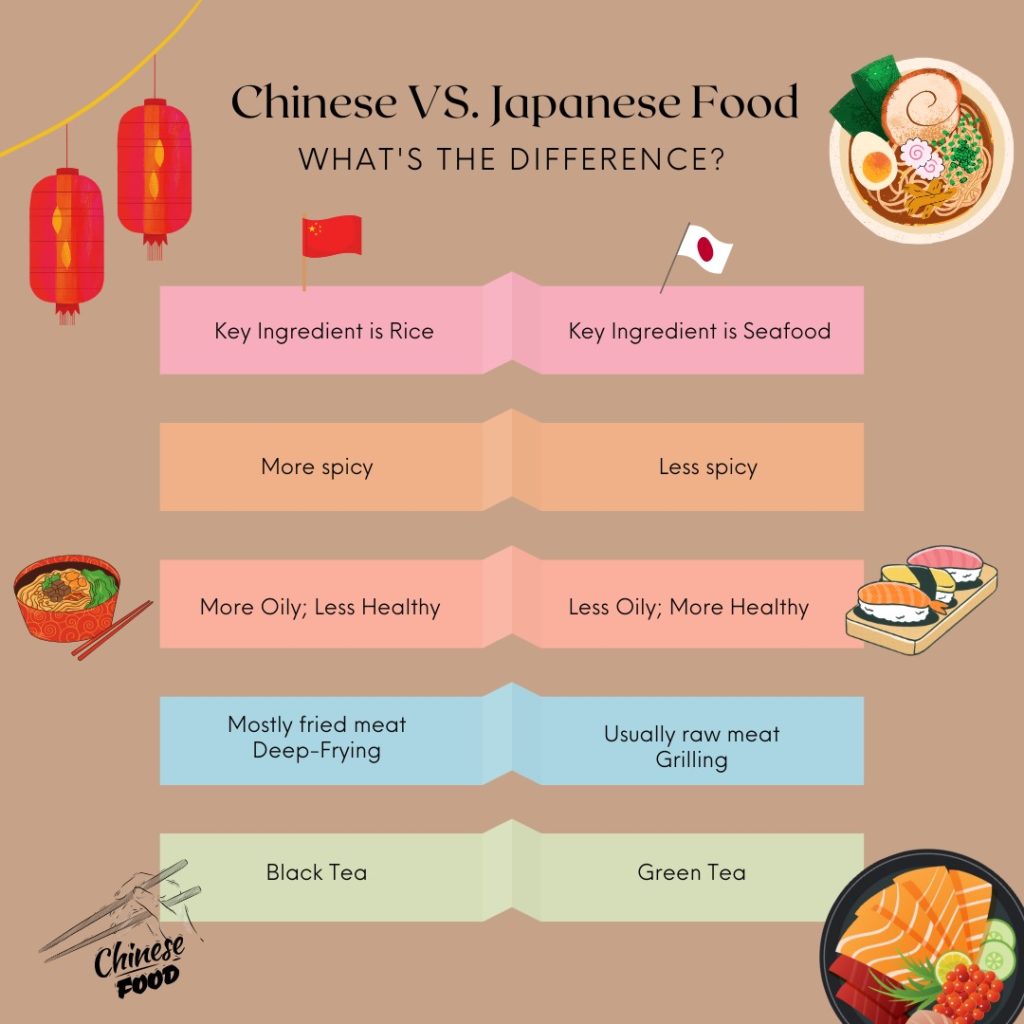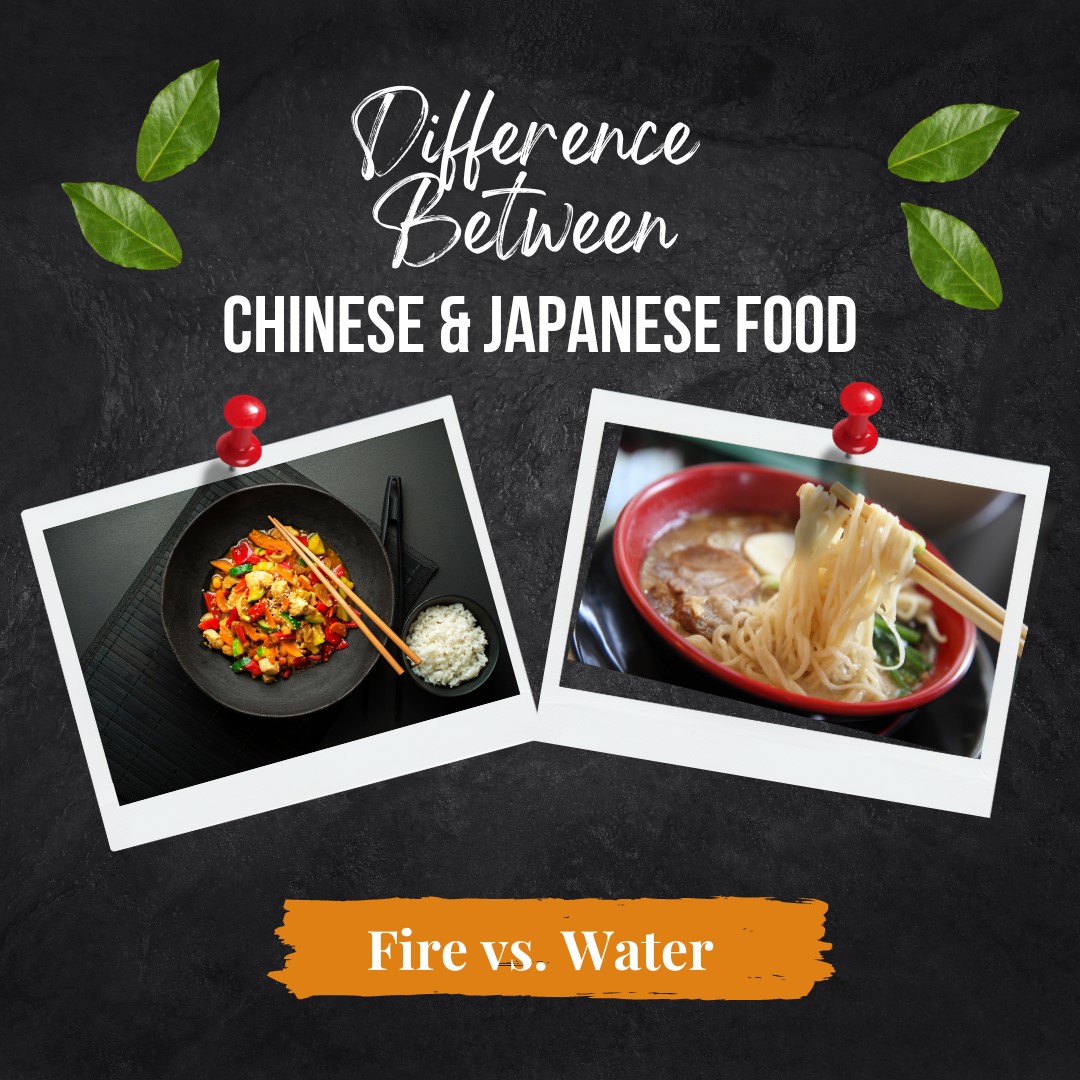Asian cuisine is authentic and traditional cookery enriched in flavors and aromas of Asian condiments and spices. The enormous gastronomy accompanies Southeast, East, Central, and Middle East cuisines. Chinese and Japanese cuisine falls under East Asian cookery, where the key ingredients are rice, noodles, garlic, ginger, onions, sesame seeds, tofu, soya, and vinegar.
Moreover, rice is the staple of Asian cuisine; Chinese rice tends to be long, while Japanese rice uses short-grain rice. Do you want to know more about “What is The Difference Between Chinese and Japanese Food?” Here are the details.
What is The Difference Between Chinese and Japanese Food?
“Chinese cuisine is Fire while Japanese cuisine is Water.” It is a famous proverb popular among old Chefs. It reflects that Japanese food is pleasant, calming, and comfortable. These are either prepared using raw meat or boiling or stir-frying. Moreover, the Japanese use fewer spices and condiments, making their food look delicate.
In contrast, Chinese cuisine is fire because of the deep-frying and stir-frying cooking techniques used to prepare food. Also, the Chinese use more spices and condiments that make their food look fiery and spicy. Besides this conventional contrast, there are several other significant differences explained below.
Chinese Foods vs. Japanese Foods

Cooking Technique and Utensil
Chinese uses traditional wok (deep pan) to fry foods evenly. Mostly they use deep-frying and stir-frying cooking technique. Since Chinese cuisine uses a lot of oil/grease, the meals are heavy and satisfy your appetite for a long. Moreover, Chinese standard cooking techniques include:
- Braising
- Roasting
- Deep-frying
- Stir-frying
- Boiling
- Steaming
In comparison, Japanese cuisine uses a flat grilling pan called “Teppan.” Japanese Chefs and home cooks use this kitchen utensil for grilling proteins and stir-frying vegetables. Nevertheless, most Japanese restaurants and Chefs prepare exotic delicacies using raw seafood. The most common example is sushi. Standard Japanese cooking techniques and styles include:
- Namamono (Fresh and Raw)
- Nimono (Simmering)
- Mushimono (Steaming)
- Yakimono (Broiling)
- Less used Agemono (Deep-frying)-Chefs carefully consider the oil’s quality, quantity, and temperature to keep food healthy using this cooking technique.
Key Ingredients
The key ingredient in Chinese cuisine is Rice, particularly long-grain white rice, the primary carbohydrate source. Most people prefer using Jasmine white rice of medium grain, having a slight aroma, delicate texture, and sweet taste. In addition to being boiled, the rice is also stir-fried. Other common ingredients include:
- Light and dark soy sauce,
- White rice vinegar,
- Sichuan peppercorns,
- Sesame oil,
- Chili bean sauce, and
- Fermented black beans
In contrast, Japanese cuisine is all about seafood like Unagi (Japanese Freshwater Eel), Uni (Sea Urchin), Hotate (scallops), Shishamo (Willo leaf fish), Kamaboko (Fish cake), Ebi (Shrimp), and Ikuro (Salmon Roe). Other common ingredients native to Japan include mirin, rice vinegar, miso paste, bonito flakes, wakame, kombu, nori, shichimi togarashi, wasabi, and noodles.
Condiments and Spices
Chinese cuisine uses a lot of condiments and spices, making their meals spicy and enriched in flavors. Popular seasonings and spices include rice wine, soy sauce, hoisin sauce, sesame oil, chili bean sauce, star anise, cumin, fennel, bay leaves, and rice vinegar. In comparison, Japanese foods are enriched with flavors and aromas of Japan-special seasonings and spices, e.g., ginger, turmeric, wasabi, cloves, cinnamon, mirin, soy sauce, miso paste, bonito flakes, kombu, wakame, and shichimi togarashi.
Taste
Salty, Spicy, Sweet, and Bitter are the five flavors that describe Chinese cuisine’s taste, where spicy and salty flavor dominates. The traditional Asian seasonings and condiments bring about these flavors. In contrast, Japanese cuisine has all five flavors similar to Chinese except for the sixth flavor, Umami. Umami is a deep flavor- a mix of bitterness, saltiness, and savoriness.
Healthiness (Proteins, Carbs, and Fats)
Generally, Japanese foods are considered healthier and more nutritious than Chinese meals. The reason lies in the use of fats, carbs, and proteins. Japanese cuisine uses a lot of proteins, and the primary source is seafood. Usually, the Japanese serve raw seafood. However, some prefer steaming and stir-frying. Other protein sources are chicken, beef, lamb, and pork.
In comparison, the Chinese rely on cow meat, chicken, lamb, pork, and shellfish for protein sources. According to reports, China uses only 65.9 grams of protein per day, much less than Japan. Regarding fat consumption, since the Chinese prefer deep-frying, they use more oil/fats than the Japanese, who love grilling (Hibachi) and broiling. Also, the Chinese use more rice than the Japanese. These are all the reasons which are why Japanese foods are more nourishing than that Chinese. Nevertheless, this does not mean that Chinese foods are unhealthy; they are just high in calories.
Teas with Food
Japanese and Chinese, belonging to East Asian cuisines, love having teas beside their meals. Generally, the Chinese prefer having black teas, whereas the Japanese sip green teas. Chinese black teas are, in fact, red teas due to the dark reddish color of the brewed and fermented tea leaves. Also known as Hong Cha, these tea leaves originate from the Camellia sinensis plant.
Moreover, green tea is the most devoured beverage in Japan, famous for its therapeutic and healing properties. They contain antioxidants, amino acids, and flavonoids that help improve heart and brain function, lose weight and promote bone health. Types of Japanese green teas include Sencha, Matcha, Hojicha, Gyokuro, and Genmaicha, and less Popular are Bancha, Konacha, Kukicha, and Ryokucha.
What are some Popular Japanese Meals?
Popular Japanese Meals are:
- Sushi
- Udon
- Ramen
- Tempura
- Sashimi
- Tamagoyaki
- Soba
- Tonkatsu
- Miso soup
- Onigiri
- Natto
- Oden
If you want to enjoy the real taste of Japanese Food visit Sanraku Japanese Food Restaurant
What are some Popular Chinese Foods?
Popular Chinese meals are:
- Hotpot
- Dumplings
- Chow Mein
- Kung Pao Chicken
- Manchurian
- Wontons
- Chicken 65
- Orange Chicken
- Yangchow Fried Rice
- Roasted Duck
- Pork
- Spring Rolls
Final Verdict
Though Japanese and Chinese foods belong to East Asian cuisine, there are several differences between these two. Japanese food uses fresh and raw ingredients and is less oily, which is why these are more healthy compared to Chinese cuisine comprising deep-fried proteins and more spices and condiments. Further details of these dissimilarities are explained above.
Also Read: How Healthy Is Agedashi Tofu? Nutritional Facts and Recipe

